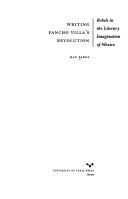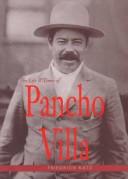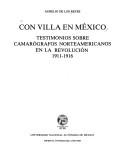| Listing 1 - 5 of 5 |
Sort by
|

ISBN: 0292706979 0292709781 029279620X Year: 2005 Publisher: Austin (TX) : University of Texas Press,
Abstract | Keywords | Export | Availability | Bookmark
 Loading...
Loading...Choose an application
- Reference Manager
- EndNote
- RefWorks (Direct export to RefWorks)
The 1910 Mexican Revolution saw Francisco "Pancho" Villa grow from social bandit to famed revolutionary leader. Although his rise to national prominence was short-lived, he and his followers (the villistas) inspired deep feelings of pride and power amongst the rural poor. After the Revolution (and Villa's ultimate defeat and death), the new ruling elite, resentful of his enormous popularity, marginalized and discounted him and his followers as uncivilized savages. Hence, it was in the realm of culture rather than politics that his true legacy would be debated and shaped. Mexican literature following the Revolution created an enduring image of Villa and his followers. Writing Pancho Villa's Revolution focuses on the novels, chronicles, and testimonials written from 1925 to 1940 that narrated Villa's grassroots insurgency and celebrated—or condemned—his charismatic leadership. By focusing on works by urban writers Mariano Azuela (Los de abajo) and Martín Luis Guzmán (El águila y la serpiente), as well as works closer to the violent tradition of northern Mexican frontier life by Nellie Campobello (Cartucho), Celia Herrera (Villa ante la historia), and Rafael F. Muñoz (¡Vámonos con Pancho Villa!), this book examines the alternative views of the revolution and of the villistas. Max Parra studies how these works articulate different and at times competing views about class and the cultural "otherness" of the rebellious masses. This unique revisionist study of the villista novel also offers a deeper look into the process of how a nation's collective identity is formed.
Mexican prose literature --- History and criticism. --- Villa, Pancho, --- In literature. --- Mexico --- History --- Literature and the revolution. --- Mexican literature --- Vilʹi︠a︡, Pancho, --- Villa, Francisco, --- Arrango, Doroteo, --- Arango, Doroteo, --- Germán, Doroteo Arango, --- Arango Arámbula, José Doroteo,
Book
ISBN: 8420729590 Year: 1988 Publisher: Madrid Anaya
Abstract | Keywords | Export | Availability | Bookmark
 Loading...
Loading...Choose an application
- Reference Manager
- EndNote
- RefWorks (Direct export to RefWorks)
Villa, Pancho, --- Zapata, Emiliano, --- Zapata Salazar, Emiliano, --- Salazar, Emiliano Zapata, --- Vilʹi︠a︡, Pancho, --- Villa, Francisco, --- Arrango, Doroteo, --- Arango, Doroteo, --- Germán, Doroteo Arango, --- Arango Arámbula, José Doroteo, --- Mexico --- History --- Villa, Francisco --- Zapata, Emiliano

ISBN: 0804730466 9780804765176 0804765170 0804730458 9780804730457 9780804730464 Year: 1998 Publisher: Stanford, California : Stanford University Press,
Abstract | Keywords | Export | Availability | Bookmark
 Loading...
Loading...Choose an application
- Reference Manager
- EndNote
- RefWorks (Direct export to RefWorks)
Alongside Moctezuma and Benito Juárez, Pancho Villa is probably the best-known figure in Mexican history. Villa legends pervade not only Mexico but the United States and beyond, existing not only in the popular mind and tradition but in ballads and movies. There are legends of Villa the Robin Hood, Villa the womanizer, and Villa as the only foreigner who has attacked the mainland of the United States since the War of 1812 and gotten away with it. Whether exaggerated or true to life, these legends have resulted in Pancho Villa the leader obscuring his revolutionary movement, and the myth in turn obscuring the leader. Based on decades of research in the archives of seven countries, this definitive study of Villa aims to separate myth from history. So much attention has focused on Villa himself that the characteristics of his movement, which is unique in Latin American history and in some ways unique among twentieth-century revolutions, have been forgotten or neglected. Villa’s División del Norte was probably the largest revolutionary army that Latin America ever produced. Moreover, this was one of the few revolutionary movements with which a U.S. administration attempted, not only to come to terms, but even to forge an alliance. In contrast to Lenin, Mao Zedong, Ho Chi Minh, and Fidel Castro, Villa came from the lower classes of society, had little education, and organized no political party. The first part of the book deals with Villa’s early life as an outlaw and his emergence as a secondary leader of the Mexican Revolution, and also discusses the special conditions that transformed the state of Chihuahua into a leading center of revolution. In the second part, beginning in 1913, Villa emerges as a national leader. The author analyzes the nature of his revolutionary movement and the impact of Villismo as an ideology and as a social movement. The third part of the book deals with the years 1915 to 1920: Villa’s guerrilla warfare, his attack on Columbus, New Mexico, and his subsequent decline. The last part describes Villa’s surrender, his brief life as a hacendado, his assassination and its aftermath, and the evolution of the Villa legend. The book concludes with an assessment of Villa’s personality and the character and impact of his movement.
Villa, Francisco --- Villa, Pancho --- Mexico --- History --- Revolution, 1910-1920 --- Chihuahua (Mexico : State) --- Villa, Pancho, - 1878-1923. --- Mexico - History - Revolution, 1910-1920. --- Chihuahua (Mexico : State) - History. --- Social movements --- History. --- Villa, Pancho, --- Movements, Social --- Social history --- Social psychology --- Vilʹi︠a︡, Pancho, --- Villa, Francisco, --- Arrango, Doroteo, --- Arango, Doroteo, --- Germán, Doroteo Arango, --- Arango Arámbula, José Doroteo,

ISBN: 9688374210 Year: 1985 Publisher: Mexico Universidad nacional autónoma de México
Abstract | Keywords | Export | Availability | Bookmark
 Loading...
Loading...Choose an application
- Reference Manager
- EndNote
- RefWorks (Direct export to RefWorks)
History of Mexico --- Film --- Villa, Francisco --- anno 1910-1919 --- Revolutions in motion pictures --- Révolutions au cinéma --- Villa, Pancho, --- Frontier troubles --- Incidents de frontière --- Révolutions au cinéma --- Incidents de frontière --- Cinematographers --- Newsreels --- Public opinion --- Filmstrips, Newsreel --- News films --- Newsreel --- Nonfiction films --- Actualities (Motion pictures) --- Motion picture journalism --- Cameramen, Lighting --- Directors of photography (Cinematographers) --- Lighting cameramen --- Photographers --- Attitudes --- History --- Vilʹi︠a︡, Pancho, --- Villa, Francisco, --- Arrango, Doroteo, --- Arango, Doroteo, --- Germán, Doroteo Arango, --- Arango Arámbula, José Doroteo, --- Public opinion. --- Mexico --- Meksiko --- Stany Zjednoczone Meksyku --- Meksyk --- Estados Unidos Mexicanos --- Meḳsiḳe --- Mexique (Country) --- Messico --- Méjico --- República Mexicana --- United States of Mexico --- United Mexican States --- Anáhuac --- メキシコ --- Mekishiko --- מקסיקו --- Motion pictures and the revolution. --- Pictorial works. --- Maxico --- Mexique --- Pictorial works --- Histoire --- Ouvrages illustrés
Book
ISBN: 9783830675600 3830675607 Year: 2012 Volume: 155 30 Publisher: Sankt-Ottilien EOS
Abstract | Keywords | Export | Availability | Bookmark
 Loading...
Loading...Choose an application
- Reference Manager
- EndNote
- RefWorks (Direct export to RefWorks)
Monastic and religious life --- Worship --- Christian life --- History --- Dorotheus, --- 248*31 --- Oosters-orthodoxe spiritualiteit --- Criticism and interpretation. --- 248*31 Oosters-orthodoxe spiritualiteit --- Church history --- Monastic life --- Spirituality (in religious orders, congregations, etc.) --- Monasticism and religious orders --- Spiritual life --- Vows --- Christianity --- Doroḟeĭ, --- Doroteĭ, --- Dorotej, --- Doroteo, --- Dorothée, --- Dorotheos, --- Monastic and religious life - Gaza Strip - Gaza - History - Early church, ca 30-600 --- Worship - History - Early church, ca 30-600 --- Christian life - Early works to 1800 --- Dorotheus, - of Gaza, Saint, - active 6th century --- Dorotheus, - of Gaza, Saint, - active 6th century - Didaskaliai --- Doroḟeĭ --- Doroteĭ --- Dorotej --- Doroteo --- Dorothée --- Dorotheos --- Dorotheus
| Listing 1 - 5 of 5 |
Sort by
|

 Search
Search Feedback
Feedback About
About Help
Help News
News